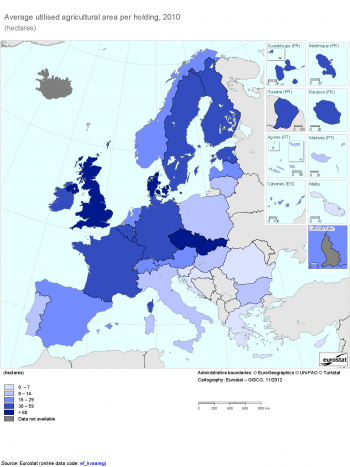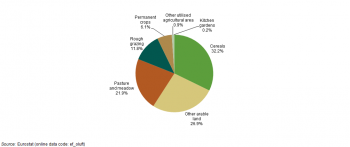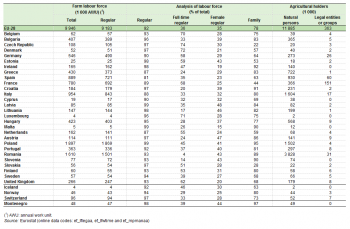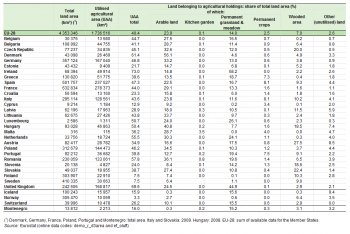Archive:Farm structure statistics
- Data from April 2014. Most recent data: Further Eurostat information, Main tables and Database. Planned article update: December 2015.

(hectares) - Source: Eurostat (ef_kvaareg)


(% share of utilised agricultural area) - Source: Eurostat (ef_oluft)
The structure of agriculture in the Member States of the European Union (EU) varies as a function of differences in geology, topography, climate and natural resources, as well as the diversity of regional activities, infrastructure and social customs. The survey on the structure of agricultural holdings, also known as the farm structure survey (FSS), helps assess the agricultural situation across the EU, monitoring trends and transitions in the structure of agricultural holdings, while also modelling the impact of external developments or policy proposals.
This article presents some statistics from the most recent farm structure survey that was conducted as a census in 2009 or 2010 and compares these with results from the previous farm structure survey in 2007 and the previous census in 2000. It should be noted that some methodological and legislative changes occurred between the 2007 and 2010 surveys: in some EU Member States (for example, the Czech Republic, Germany, Poland, Slovakia and the United Kingdom) there was a reduction in the coverage of the survey that resulted from an increase in the minimum size threshold for agricultural holdings.
Main statistical findings
Developments between 2000 and 2010
In the last decade there has been a general tendency for a reduction in the number of agricultural holdings in the EU. For the 19 EU Member States for which 2000 and 2010 census results were available at the time of writing (see Table 1), the total number of holdings fell by an average of 25.5 %. This downward tendency can be seen in all 19 of these Member States; there were particularly fast structural changes in Slovakia, Latvia, Hungary and Germany; as noted above this may reflect methodological as well as structural changes.
A comparison of the 2010 census results with the most recent farm structure survey from 2007 suggests this structural change remains an ongoing process; data are available for these two reference periods for all EU-28 Member States. Most countries recorded a fall in their respective number of holdings between these two survey years, as the only exceptions were Ireland, Croatia, Malta and Portugal [1], where the number of holdings was higher in 2010 than in 2007.
Based on the 2010 data, there were around 12.2 million agricultural holdings within the EU-28. An analysis by economic size shows that among these there were 7.0 million (or 57.4 %) that had a standard output in excess of EUR 2 000. The number of agricultural holdings with a standard output above EUR 2 000 was 9.3 % lower in 2010 than it was in 2007, whereas the total number of holdings was 13.9 % lower; the difference between these two rates may reflect the impact of methodological changes combined possibly with a relatively faster contraction in the number of smaller holdings (with a standard output below EUR 2 000).
The utilised agricultural area (UAA) in the EU-28 was approximately 176 million hectares (around 40 % of the total land area), giving an average size of 14.4 hectares per agricultural holding. Map 1 provides a more detailed analysis of the average size of agricultural holdings. Half of the 28 EU Member States recorded an increase in their utilised agricultural area between 2007 and 2010 [2]; collectively there was an increase of 1.4 % in the EU-28’s utilised agricultural area. By far the largest relative increase between 2007 and 2010 was in Bulgaria (46.7 %), followed by Croatia (34.5 %), Greece (27.0 %), Ireland (20.6 %), Hungary and Malta (both 10.8 %).Among the Member States where the utilised agricultural area contracted, by far the most notable was in Cyprus where the area decreased by 18.9 %. Between 2000 and 2010 (data available for 19 Member States), the utilised agricultural area increased 44.5 % in Greece, 25.4 % in Latvia and 12.3 % in Ireland, while it fell 15.1 % in Austria and 12.2 % in Slovakia.
As well as determining the size of farms in terms of their agricultural area, economic size can be determined by reference to the standard output, in other words, the value of agricultural output at farm-gate prices. Based on this measure, agricultural output increased (in current price terms) between 2007 and 2010 in nearly all of the EU Member States, most notably in Croatia, Slovakia, Latvia, Portugal, Italy, Denmark and Estonia, where growth above 20 % was observed. Nevertheless, between 2007 and 2010 standard output contracted in Cyprus, Greece, Germany and Ireland, while in Sweden it was more or less unchanged.
The farm labour force fell in all 18 EU Member States for which 2000 and 10 results are available. The overall change during these ten years ranged from -11.7 % in Germany to -41.8 % in Finland, with Ireland (-1.8 %) above this range and Slovakia (-58.9 %) below it. Most of the 23 Member States for which 2010 data are available also recorded a fall in their respective farm labour forces when compared with the situation in 2007, the exceptions being Malta (a 15.4 % increase), Ireland (12.1 %), Portugal (7.5 %) and Hungary (5.0 %). The largest declines in the agricultural labour force between 2007 and 2010 were in Slovakia, Austria, Cyprus, Romania and Italy, all of which saw their respective labour forces contract by at least one quarter. There was a 16.1 % fall in the EU-28’s agricultural labour force between 2007 and 2010, from 11.9 million annual work units (AWU) to 9.9 million annual work units.
The total number of livestock units increased between 2000 and 2010 by 12.8 % in Denmark and by 6.6 % in Latvia; these were the only two Member States to record an increase in their number of livestock units among the 19 EU Member States with data available for 2000 and 2010. The largest contractions in livestock between these years were recorded for Slovakia and Hungary.
Developments between 2007 and 2010 for the number of livestock units show that a majority of EU Member States recorded a decline in livestock units. Overall, the number of livestock units in the EU-28 fell from 136.8 million to 135.2 million, a reduction of 1.2 %. The largest relative increases in livestock numbers between 2007 and 2010 were in Croatia (15.5 %), Portugal (8.7 %) and Denmark (7.4 %), while the largest declines were in Cyprus (-18.6 %), the Czech Republic and Malta (both -16.1 %).
The farm labour force
The total farm labour force in the EU-28 was the equivalent of 9.9 million annual working units (AWUs) in 2010, of which 9.2 million (92 %) were regular workers (see Table 3). Agriculture remains very much a family-oriented activity in the majority of EU Member States; nearly four in every five (78 %) members of the total agricultural labour force were farm holders or members of their families. The main exceptions were Slovakia (28 %) and the Czech Republic (22 %), where there is a different ownership structure, as well as France (44 %). Just over one third (35 %) of the regular agricultural labour force in the EU-28 was female, although in the Baltic Member States and Austria this share was closer to half, peaking at 48 % in Latvia. Among EU-28 agricultural holders, the vast majority (97.0 %) were natural persons; France alone accounted for more than two fifths of the holdings in the EU-28 that were under the control of legal entities or groups.
Agricultural land use
Two fifths (40.1 %) of the total land area of the EU-28 was utilised agricultural area in 2010, with a further 9.6 % of the land area also belonging to agricultural holdings, either in the form of wooded areas or other land not used for agriculture. The proportion of the land area that was utilised agricultural area rose to nearly three quarters (73.0 %) in Ireland and was more than two thirds of the total (69.6 %) in the United Kingdom; by contrast, it was less than one tenth of the total in Sweden and Finland (both 7.5 %).
Arable land (which includes cereals and other arable land) accounted for three fifths (59.1 %) of the utilised agricultural area in the EU-28 in 2010 (see Figure 1), with permanent grassland (which is composed of pasture, meadow and rough grazing) accounting for 33.7 %. Permanent crops, such as vineyards, olive trees and orchards, accounted for a 6.1 % share and kitchen gardens around 0.2 %.
Data sources and availability
A comprehensive farm structure survey is carried out by EU Member States every ten years (the full scope being the agricultural census) and intermediate sample surveys are carried out three times between these basic surveys. The EU Member States collect information from individual agricultural holdings, covering:
- land use;
- livestock numbers;
- rural development (for example, activities other than agriculture);
- management and farm labour input (including age, sex and relationship to the holder).
The survey data are aggregated to different geographic levels (countries, regions, and for basic surveys also districts) and arranged by size class, area status, legal status of holding, objective zone and farm type.
In preparation for the 2010 survey a new legal basis was developed: Regulation (EC) 1166/2008 of the European Parliament and of the Council of 19 November 2008 on farm structure surveys and the survey on agricultural production methods.
The basic unit underlying the survey is the agricultural holding, a technical-economic unit under single management engaged in agricultural production. Until 2007, the farm structure survey covered all agricultural holdings with a utilised agricultural area (UAA) of at least one hectare (ha) and those holdings with a UAA of less than one hectare if their market production exceeded certain natural thresholds. Under the new legislation, the minimum threshold for agricultural holdings changed from one hectare to five hectares for the 2010 survey. The new five hectare threshold was adopted in the Czech Republic, Germany and the United Kingdom. In Luxembourg, the threshold was changed to three hectares, in Sweden to two hectares, and in the Netherlands the threshold was of a minimum of EUR 3 000 of standard output (see below for more details).
The new legislation also changed the coverage of the survey from 99 % of the standard gross margin to 98 % of the UAA (excluding common land) and 98 % of the livestock. Common land (land shared by several holdings) is not included in the UAA in the case of Bulgaria, Germany, France, Greece, Ireland, Hungary, Slovenia and the United Kingdom. In all other countries it either does not exist or has been included in the survey.
The standard output of an agricultural product (crop or livestock) is the average value of agricultural output at farm-gate prices, in euro per hectare or per head of livestock. There is a regional coefficient for each product based on an average value over five years. Until 2007, the farm structure survey used the standard gross margin to classify agricultural holdings by type of farming and by economic size but this was replaced by the concept of standard output for the 2010 census. It should be noted that the standard output excludes direct payments.
The farm labour force is made up of all individuals who have completed their compulsory education (having reached school-leaving age) and who carried out farm work on the holding under survey during the 12 months up to the survey day. The figures include holders, even when not working on the holding, whereas their spouses are counted only if they carry out farm work on the holding. The holder is the natural person (sole holder or group of individuals) or the legal person (for example, a cooperative or other institution) on whose account and in whose name the holding is operated and who is legally and economically responsible for the holding — in other words, the entity or person that takes the economic risks of the holding; for group holdings, only the main holder (one person) is counted. The regular labour force covers the family labour force and permanently employed (regular) non-family workers. The family labour force includes the holder and the members of his/her family who carried out farm work (including all persons of retiring age who continue to work on the holding). One annual work unit (AWU) corresponds to the work performed by one person who is occupied on an agricultural holding on a full-time basis. Full-time means the minimum hours required by the national provisions governing contracts of employment. If these provisions do not explicitly indicate the number of hours, then 1 800 hours are taken to be the minimum (225 working days of eight hours each).
Context
Rural development policy aims to improve: competitiveness in agriculture and forestry; the quality of the environment and countryside; life in rural areas; and the diversification of rural economies. As agriculture has modernised and the importance of industry and more recently services within the economy has increased, so agriculture has become much less important as a source of jobs. Consequently, increasing emphasis is placed on the role farmers can play in rural development, including forestry, biodiversity, the diversification of the rural economy to create alternative jobs and environmental protection in rural areas.
The common agricultural policy (CAP) has been frequently reformed in an attempt to modernise the sector and make it more market-oriented. After almost two years of negotiations between the European Commission, the European Parliament and the Council, a political agreement on the reform of the CAP was reached on 26 June 2013. The agreement was designed to lead to far-reaching changes: making direct payments fairer and greener, strengthening the position of farmers within the food production chain, and making the CAP more efficient and more transparent, while providing a response to the challenges of food safety, climate change, growth and jobs in rural areas, thereby helping the EU to achieve its overall objective of promoting smart, sustainable and inclusive growth. The farm structure survey continues to be adapted with the aim of trying to provide timely and relevant data to help analyse and follow these developments. More information on the reform of the CAP is provided in the introductory article for agriculture, forestry and fisheries statistics introduced.
See also
- 2007 farm structure survey — includes links to articles for the EU, for individual EU Member States as well as EFTA countries
- 2010 agricultural census — includes links to articles for the EU, for individual EU Member States as well as EFTA countries
- Agri-environmental indicators
- Agriculture statistics - the evolution of farm holdings
- Farm structure survey (FSS)
Further Eurostat information
Publications
- Agriculture, forestry and fishery statistics — 2013 edition (Pocketbook)
- Agriculture, fishery and forestry statistics — Main results — 2010–11 — 2012 edition (Pocketbook)
- Agricultural statistics — Main results 2008–09 (Pocketbook)
- Agriculture — Main statistics 2005–2006 (Pocketbook)
Main tables
- Agriculture (t_agri), see:
- Farm structure: historical data (1990-2007) (t_ef)
Database
- Agriculture (agri), see:
- Farm structure (ef)
- Farm structure 2010 (ef_2010)
- Key farm variables (ef_kv)
- Overview - Farm land use (ef_olu)
- Overview - Farm livestock (ef_ols)
- Overview - Farm labour force (ef_olf)
- Farm land use - Arable land (ef_ala)
- Farm land use - Permanent crops, other farmland, irrigation (ef_po)
- Farm livestock and fodder crops (ef_lsf)
- Farm labour force (ef_lf)
- Other gainful activities and support for rural development (ef_oga)
- Farm management and practises (ef_mp)
- Survey on agricultural production methods (SAPM, 2010) (ef_pm)
- Farm structure: historical data (1990-2007) (ef_h)
- Farm structure 2010 (ef_2010)
Dedicated section
Methodology / Metadata
- Farm structure (ESMS metadata file — ef_esms)
- Farm structure — Methodology of Community surveys
- National Methodological Reports
Source data for tables, figures and map (MS Excel)
Other information
- Regulation 1166/2008 on farm structure surveys and the survey on agricultural production methods (farm structure survey from 2010 onwards)
- Commission Regulation 1200/2009 implementing Regulation 1166/2008 on farm structure surveys and the survey on agricultural production methods (farm structure survey from 2010 onwards)
- Regulation 1242/2008 establishing a Community typology for agricultural holdings (standard output typology)
- Commission decision 115/2000 of 24 November 1999 relating to the definitions of the characteristics, the list of agricultural products, the exceptions to the definitions and the regions and districts regarding the surveys on the structure of agricultural holdings
- Regulation 571/88 of 29 February 1988 on the organization of Community surveys on the structure of agricultural holdings between 1988 and 1997
- Commission Decision 85/377/EEC of 7 June 1985 establishing a Community typology for agricultural holdings
External links
Notes
- ↑ The increase in the number of agricultural holdings in Portugal is related to the fact that the 2007 survey was based on a sample from the register produced by the 1999 census; the eight year gap between the 1999 census and the 2007 sample survey led to results that were influenced by the relatively outdated register.
- ↑ In the case of Bulgaria, Germany, Ireland, France, Hungary and Slovenia common land area was included for the first time in the 2010 survey; common land is excluded in the case of Greece (1.7 million hectares) and the United Kingdom (2.4 million hectares).


